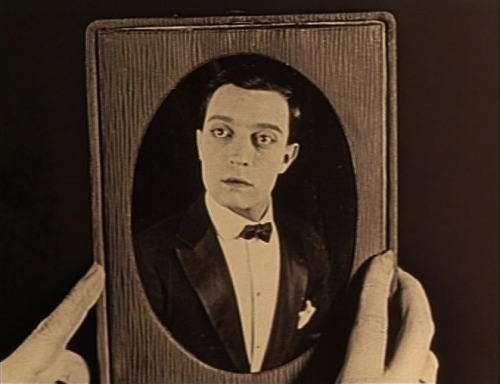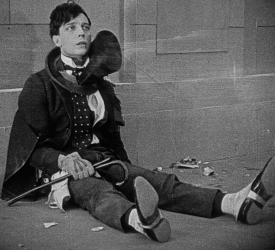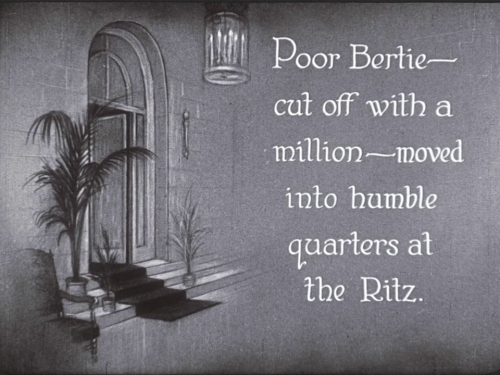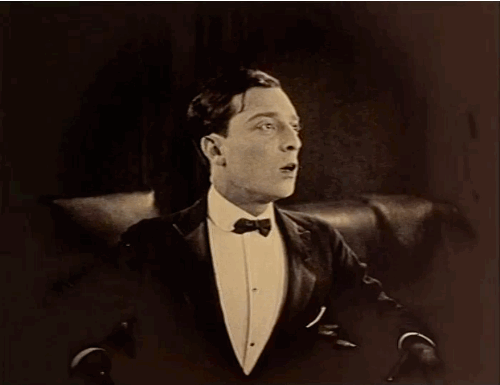Uma peça da Broadway chamada “The New
Henrietta” permitiu que dois dos maiores atores do cinema mudo renovassem suas
carreiras. Depois de estrelar a peça na Broadway em 1915, Douglas Fairbanks era
a escolha óbvia para protagonizar a adaptação para o cinema, “The Lamb” (1915)
- seu primeiro filme. Quando um remake foi feito em 1920, Fairbanks, já um
ídolo das telas, recomendou que Buster Keaton fizesse seu papel. E “O Pesado”
(1920) foi o primeiro longa-metragem de Keaton.
A Broadway play called “The New Henrietta” allowed
two of the biggest silent actors to do new things with their careers. Having
starred the play on Broadway in 1915, Douglas Fairbanks was the obvious choice
to star the film adaptation, “The Lamb” (1915) - his first film. When the film was
remade in 1920, Fairbanks, already an established screen idol, recommended
Buster Keaton for his role. And “The Saphead” (1920) was Keaton’s
first feature film.
Os créditos não podiam ser mais
fofos. Os perfis dos atores aparecem em pequenas janelas ovais, semelhantes a
camafeus, então se movem e desaparecem, até aparecer o maior dos camafeus com o
perfil de Buster. Nosso Buster é Bertie Van Alstyne, o filho do ricaço Nick de
Wall Street (William H. Crane). O pai dele pode ser um magnata, mas a única preocupação
de Bertie é conquistar uma garota adotada por seu pai, Agnes (Beulah Booker). A
outra filha de Nick é Rose (Carol Holloway), casada com Mark Turner (Irving
Cummings). Mark tem um grande problema: sua amante, Henrietta, tem vários
cartas de amor para incriminá-lo.
The credits couldn’t be cuter. The actors’ profiles
appear in little oval windows, like cameos, become animated and fade, until the
biggest cameo, that has Buster. Our Buster is Bertie Van Alstyne, the son of
the rich Nick of the Street, Wall Street of course (William H. Crane). His
father may be a mogul, but Bertie’s only affliction is conquering his father’s
protégé, Agnes (Beulah Booker). Nick’s other child is Rose (Carol Holloway),
married to Mark Turner (Irving Cummings). Mark has a huge problem: his lover,
Henrietta, has a lot of incriminatory love letters.
Bertie leu um manual para conquistar
a mulher moderna, e por isso decide que precisa de reputação de bad boy, que fuma e joga, quando ele não
consegue encontrar Agnes na estação de trem - porque ele foi à estação errada -
ele decide sair com os amigos e ir até um cassino ilegal. Agnes fica com a
impressão de que ele passa as noites com garotas, o que a entristece, porque
ela também é apaixonada por Bertie.
Bertie has been reading a manual to win the
modern lady, and wants to build a bad boy reputation, by gambling and smoking.
When he can’t meet Agnes at the train station - because he went to the wrong
station - he decides to go out with friends and go to an illegal gambling
palace. Agnes gets the impression that he spends nights with other girls and
becomes heartbroken, because she, too, loves Bertie.
Quando as coisas com Agnes parecem se
acertar, Bertie é expulso de casa pelo pai, que não gostou de ver o filho envolvido
no escândalo do cassino clandestino. Nick dá a seu filho parcos um milhão de
dólares para que ele sobreviva até encontrar um emprego. Bertie estabelece sua
nova residência no Hotel Ritz e passa a ser investidor na Bolsa de Valores - e
quem poderia imaginar que os membros da Bolsa eram tão infantis? Enquanto isso,
Mark está disposto a fazer qualquer coisa para não deixar a verdade sobre sua
relação com Henrietta vir à tona. Para piorar as coisas, Nick passa a vender as
ações de uma mina de ouro também chamada Henrietta.
When things with Agnes seem to be settled, Bertie
is expelled from home by his father, who didn’t like Bertie involved in the
scandal of the clandestine casino. Nick gives son only a million dollars so he
can survive until he gets a job. Bertie establishes his new residence at the
Ritz and becomes a stock broker - and who could have imagined that Stock
Exchange members were so childish? Meanwhile, Mark is willing to do anything to
not let the truth about his relationship with Henrietta surface. To make things
worse, Nick starts handling the stock papers of a gold mine also called
Henrietta.
Em “O Pesado” não há a mesma
quantidade de comédia física a que um fã de Buster Keaton está acostumado.
Claro, Buster cai da escada uma vez e dá uma cambalhota, mas é só isso. Pode
não haver muito slapstick, mas mesmo assim a comédia em “O Pesado” é muito boa.
Isso se deve ao cérebro perspicaz por trás do roteiro: June Mathis. June foi
uma roteirista autodidata que se tornou a primeira executiva da história de
Hollywood quando ela se tornou chefe do departamento de roteiros da Metro em
1918. June também foi responsável por lançar a carreira de Rodolfo Valentino.
Ela faleceu em 1927, aos 40 anos, de ataque cardíaco, e foi enterrada ao lado
de Valentino, que havia morrido no ano anterior.
There is not in “The Saphead” the common amount of
physical comedy that a Keaton fan is used to. Sure, Keaton falls down the
stairs once and does one somersault, but that’s it. There may not be so much
slapstick, but the comedy in “The Saphead” is very good nonetheless. This is
because of a witty mind behind the screenplay: June Mathis. June was a
self-taught screenwriter who became the first female film executive in
Hollywood when she became the head of the scenario department at Metro in 1918.
June was also responsible for launching Rudolph Valentino’s career. She passed
away in 1927, aged 40, from a heart attack, and was interred next to Valentino,
who died the prior year.
 |
| June Mathis |
O nome Irving Cummings soa familiar
para você? Para mim ele certamente soou: nos anos 30 e 40, Cummings dirigiu
diversos filmes na Fox, como “A Pequena Órfã” (1935) com Shirley Temple, “A
vida de Alexander Graham Bell” (1939) e “Serenata Tropical” (1940). Cummings
começou a dirigir em 1921, e foi indicado ao Oscar por “No Velho Arizona”
(1928).
Is the name Irving Cummings familiar to you? He was
certainly familiar to me: in the 1930s and 40s, Cummings directed several
movies at Fox, like Shirley Temple’s “Curly Top” (1935), “The Story of Alexander
Graham Bell” (1939) and “Down Argentine Way” (1940). Cummings started directing
in 1921, and was nominated for an Oscar for “In Old Arizona” (1928).
O diretor de “O Pesado” é Herbert
Blaché, o marido de Alice Guy. Ele e Alice fundaram a companhia Solax Film Co.
em 1910. Em dezembro de 1919 os estúdios da companhia pegaram fogo, e Alice
dirigiu seu último filme em 1920. Herbert, que trabalhava mais como produtor,
passou a trabalhar mais como diretor a partir de então. Ele e Alice
se divorciaram em 1922.
The director of “The Saphead” is Herbert Blaché,
Alice Guy’s husband. He and Alice founded the Solax Film Co. in 1910. In
December 1919 the Solax Studios caught fire, and Alice directed her last movies
in 1920. Herbert, who had been working more as producer, started directing more
from then on. He and Alice divorced in 1922.
Eu amei a decoração dos intertítulos.
Desenhar intertítulos era uma arte - não nos esqueçamos de que Hitchcock
começou no cinema nessa função. As figuras nos intertítulos não são
espirituosas, mas escolhas óbvias, e mesmo assim elas adicionam charme a um filme
já charmoso.
I loved how some title cards were decorated.
Writing title cards was an art in itself - let’s not forget that Hitchcock
started in movies by doing exactly that. The figures in the intertitles are
more obvious than clever, bot they add a charming touch to an already charming
movie.
Fairbanks pode não ter feito “O
Pesado”, mas sua ausência não foi uma grande perda. Como Bertie, Buster Keaton
é fofo, simpático e nós torcemos por ele. Não nos esqueçamos de que tanto
Fairbanks quanto Keaton eram homens bastante atléticos - pensando assim,
podemos concluir que eles não eram tão diferentes no final das contas.
Fairbanks didn’t do “The Saphead”, but his absence
was not a big loss. As Bertie, Buster Keaton is cute, sympathetic and we root
for him. Let’s not forget that both Fairbanks and Keaton were very athletic men
- thinking like this, we can conclude that they weren’t so different after all.
Mesmo se você não conhece nada da
Bolsa de Valores - assim como eu - você pode se divertir muito com “O Pesado”.
O público de 1920 com certeza se divertiu: o filme foi um sucesso de bilheteria
e Buster passou a ter seu nome no topo dos créditos a partir de então. “O
Pesado” é diferente de tudo o que você já viu de Buster, e é também um marco em
sua incrível carreira.
Even if you know nothing of the stock market - like
me - you can enjoy immensely “The Saphead”. The 1920’s audiences sure did: the
film was a box-office hit and Buster started receiving top billing from then
on. “The Saphead” is different from everything you’ve seen Buster in, and it
also was a milestone in his amazing career.
This is my contribution to the Fifth Annual Buster Keaton blogathon, hosted by Lea at Silent-ology.








4 comments:
Le! This is another Buster K film I've never seen, and your wonderful review makes me feel like I'm missing out on something special. I'll look for it ASAP – and thank you, in advance. :)
THE SAPHEAD seems to be one of the overlooked films in Buster's filmography, but it's pretty fascinating when you consider this is the first time he appeared in fancy clothes, as well as did more subtle acting than slapstick. I'll bet a lot of people who saw it in theaters thought, "Hey, it's little Buster from The Three Keatons!" or "Isn't that the young man from the Arbuckle comedies?" I like those cute introductory credits, too--old-timey touches using "modern" technology.
Thanks for contributing this to the blogathon, Le--your entries are always very appreciated! :-)
An Adorable post! Buster is so cute in this - and it is interesting to see him working something driven completely by others. Good insight into the athleticism of both Fairbanks and Keaton.
Hi Lê. sorry it took me a while to get here. I enjoyed your essay very much. I enjoyed The Saphead, and you are right, it is different. Buster could have gone in a different direction.
Post a Comment